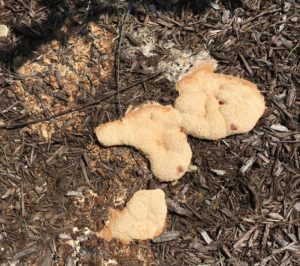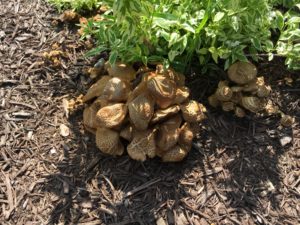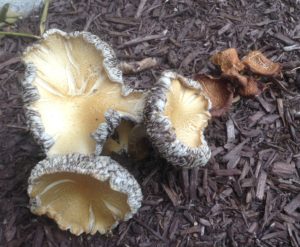Hello, Fellow Readers. Jeanne of Blairstown shared a fungi dilemma: an alien-looking plethora of mushrooms amongst her garden mulch. Mushrooms are the fruit of valuable spores that decay organic material and recycle nutrients back into the soil, which is good for plants. However, in volumes, they’re unsightly in the garden. The good news is most mushrooms are not toxic and do not cause disease, though a few are poisonous if eaten, so keep curious critters and kids away.
There are many types of mushrooms – from the classic toadstool to smelly finger-like stinkhorns that attract insects. There are the puff balls I loved to pounce as a kid to release black clouds of spores. Then there’s the bright pink, orange, or yellow slime mold that looks like a dog hurled (sorry if you’re eating breakfast). Groups of birds nest mushrooms that look like little eggs inside cups. The dreaded artillery fungus creates clusters of minute orange-brown or cream cups with black specks in the center, which shoot tarlike spores onto siding, walkways, and even on cars that are impossible to remove.
Mulch should never be more than two or three inches thick as too much inhibits air circulation needed for root health. Plus, too-thick mulch will create a mat that hinders moisture from getting through to roots and kills microorganisms that prevent spores from going into fruit, meaning you’ll have more mushrooms.
Moisture, cool temperatures, and shade provide ideal environments for mushrooms. Hand watering plants at their roots or drip irrigation, rather than sprinklers, will help limit mushroom colonies. While fungicides are used in lawns to treat short-lived fungi like leaf spot and root rot, they won’t help fungi that create mushrooms. Instead, rake mulch periodically to interrupt the fungi cycle, inhibiting them to fruit. If mushrooms have formed, remove and toss them in a bag to dispose of to prevent further spreading of spores.
Mushrooms prefer acidic soil. Adding lime can make the soil more alkaline, but it would negatively impact other acid-loving plants. They say two tablespoons of baking soda mixed with a gallon of water won’t change the chemistry or pH of soil but will disrupt the ideal conditions for fungi growth.
While you can refresh decaying mulch by adding a half inch of fresh mulch, once mushrooms begin running amuck, it’s time to remove and install new. Add the old much to the compost pile, turning every few months, to create compost soil. Using organic compost soil instead of mulch is a nourishing alternative for your plants, and it’s already broken down, so mushrooms won’t have much to feed on.
Penn State researchers discovered that blending four parts of used mushroom compost, also sold as mushroom soil, with ten parts of mulch significantly impedes artillery fungus and other annoying fungi because the compost contains beneficial microbes that destroy them. Plus, mushroom soil, the byproduct of edible mushroom production, will boost plant growth. If you can’t beat ’em, join ’em.
Garden Dilemmas? Askmarystone@gmail.com and your favorite Podcast App.
There’s more to the story in the Garden Dilemmas Podcast (a soothing 10 minutes):
Column updated 5/5/24





